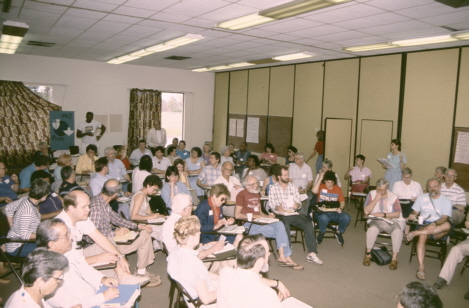 Here we are at a WFP orientation session in Miami prior to leaving for Nicaragua.
Here we are at a WFP orientation session in Miami prior to leaving for Nicaragua.
|
Ivan's Place |
|
|
|
NOTE: The complete report by the Latin American Studies Association on the 1990 election, as a 4MB
searchable PDF file, is available here.
This file requires the free Adobe Acrobat Reader.
Download the Reader here. "WFP was founded in 1983, as the Contra War raged in Nicaragua. We established an ongoing presence there and sent U.S. citizens to accompany the Nicaraguan people in war zones and to document the "human face" of the Reagan Administration's military policy. WFP led the way in bringing the brutal facts of those policies home to the U.S. public through grassroots education and large-scale media outreach. During this initial period, WFP established its successful model of merging the powerful forces of on-the-ground documentation, assertive media strategies, a dynamic delegations program, and stateside grassroots mobilization."
In a very real sense Witness for Peace volunteers were America's first
"embedded" reporters of the post-Vietnam era. In contrast to today's "embedded" journalists in Iraq, however, WFP
reporters were real thorns in the side of the administration, rather than cogs in Washington's
well-oiled disinformation machine. |
|
|
|
|
|
|
|
|
|
|
|
|
|
|
|
|
|
|
|
"The Sandinistas, for all their faults, have made enormous advances in education, housing, and health care, issues of vital importance to Nicaragua's poor majority. Unfortunately, the 'contras' burn down schools, homes, and health centers as fast as the Sandinistas build them."
See the Affidavit of Edgar Chamorro, submitted to the
International Court of Justice |
|
|
|
|
|
|
|
|
|
|
|
|
|
|
|
|
|
|
|
|
|
|
|
|
|
|
|
|
|
|
|
|
|
|
|
|
|
|
|
|
|
|
|
|
|
|
|
|
|
|
|
|
|
"Despite his considerable efforts to make peace with the Contras and hold internationally supervised elections, Ortega has been frustrated by lingering distrust and a failure to secure Western aid to rebuild his destitute country." I am perhaps exaggerating, but only slightly, in saying that the leading clause in this comment is virtually the only positive statement about Daniel Ortega and the Sandinistas made by a male Los Angeles Times reporter in the entire 9 years of coverage of the war. I suggest, too, that the contradictions contained in this statement alone could be unfolded into a Ph.D. thesis in Journalism. |
|
|
|
|
|
|
|
|
|
|
|
|
|
|
|
|
|
|
|
|
|
|
|
|
|
|
|
|
|
|
|
|
|
|
|
|
|
|
|
|
|
|
|
|
|
|
|
|
|
|
|
|
|
|
|
|
|
|
|
|
|
|
|
|
|
|
|
|
|
A few observations:
There were a few honest commentators. After the election, in March, Edgar Chamorro, seen above, was in Los Angeles.
Mike Emery, the chair of the Journalism Department at California State University, Northridge, California, convened a
panel of election observers at CSUN (including himself): Chamorro; some CSUN Latin Studies professors; Marc Cooper—a highly respected
journalist and journalism professor; and—much to my surprise— me. (I was of course very honored to be included, and my respect for Chamorro
was enormously deepened at a pre-panel breakfast with him. Mike and I had been friends since 1974, when we worked together
on behalf of the United Farm Workers Union, and we were also together on
La Marcha Por La Paz En Centro America.) "Suppose that some power of unimaginable strength were to threaten to reduce the United States to the level of Ethiopia unless we voted for its candidates, demonstrating that the threat was real. Suppose that we refused, and the threat was then carried out, the country brought to its knees, the economy wrecked and millions killed. Suppose, finally, that the threat were repeated, loud and clear, at the time of the next scheduled elections. Under such conditions, only the most extreme hypocrite would speak of a free election. Furthermore, it is likely that close to 100 percent of the population would succumb. "Apart from the last sentence, I have just described US-Nicaraguan relations for the last decade." Here Chomsky refers to the fact that after 10 years of brutal punishment, 41% of Nicaragua's voters still supported the Sandinistas. Two days after the election, the Los Angeles Times itself reported "A Los Angeles Times survey of returns from a nationwide sample of polling places showed the Sandinistas winning only in one of Nicargua's nine regions: Esteli. They were rejected by a larger margin in rural areas than in the cities, but ran virtually even in rural zones hit hardest by the civil war." Chamorro Wins in Nicaragua, Los Angeles Times, Tuesday, February 27, 1990. P.A4
Ran virtually even in rural zones hit hardest by the civil war!!
Had there been no war and no embargo; had the U.S. treated the Sandinistas with the respect they deserved, and
helped them rebuild Nicaragua according to the logic of the majority,
they would have been re-elected. Nicaragua today would be the healthiest and happiest country in Latin America—if not
the hemisphere. |
|
|
|
Top Contact me Home page Table of Contents
|